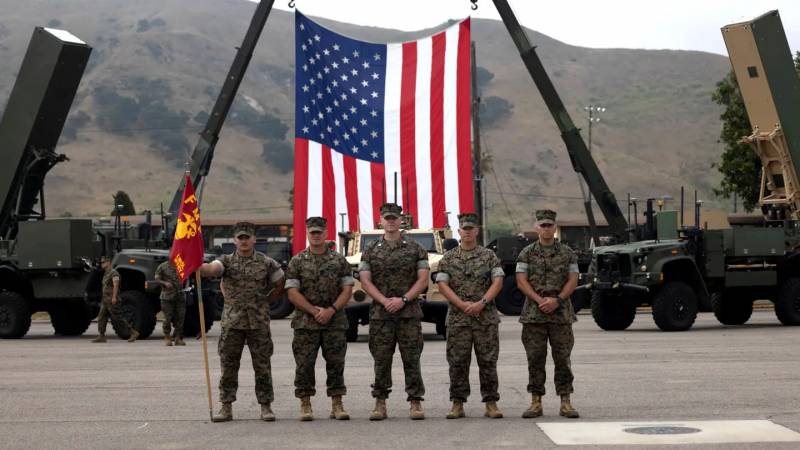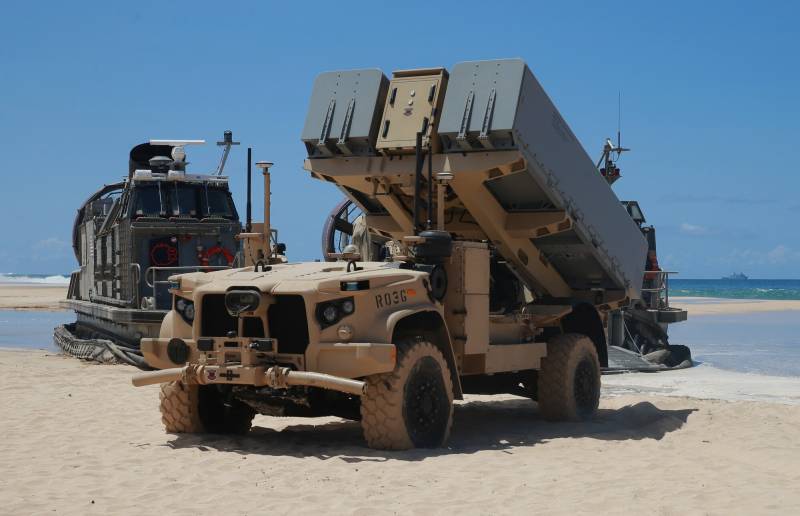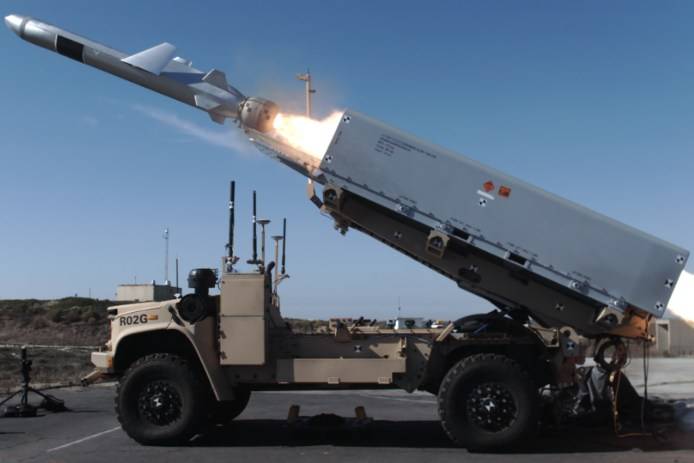US Marine Corps armed with cruise missiles

Commissioning ceremony for Company A, 11th Marines, July 21, 2023
The US Marine Corps is interested in expanding its firepower and is taking action. Over the past few years, on his order, a promising coastal missile system Long Range Fires Launcher has been developed, capable of using Tomahawk cruise missiles. This year, the first unit began its service at such complexes, and a corresponding official ceremony was recently held.
New funds
In the mid-XNUMXs, the Pentagon decided to strengthen the ILC formations with its own long-range coastal missile systems. It was proposed to create a unified platform and place on it missiles of various types, designed to combat ground and surface targets. In light of the new tactics of use, it was considered necessary to make the base platform-chassis unmanned.
The development of projects was completed at the beginning of the new decade. The ROGUE-Fires (Remotely Operated Ground Unit Expeditionary-Fires) robotic chassis was the first to be presented and sent for testing. Based on it, the NMESIS (Navy Marine Expeditionary Ship Interdiction System) missile system with the NSM anti-ship missile was completed. Not so long ago, the unified LRFL (Long Range Fires Launcher) or LMSL (Long Range Missile) complex was first shown on a similar chassis, but with a Tomahawk missile.
To date, the experimental complexes have conducted several training launches, incl. with the development of all issues of deployment and application. As a result of these events, a promising complex with a Tomahawk cruise missile received a recommendation for adoption. DBK with RCC has similar prospects. His acceptance and putting on duty is only a matter of time.

Unmanned launcher LRFL
Missiles in service
In early June, the American press, citing the ILC Development and Integration Command, reported that LRFL products had already entered service. So, at the beginning of the year, as part of the 11th Marine Regiment (Base Camp Pendleton, California), a separate company (battery) with the letter “A” was formed, which received new unmanned missile systems with cruise missiles.
At that time, the unit was engaged in the development of the received equipment and worked out the issues of its operation and application. In addition, various practical activities were planned, incl. with combat shots. As part of these exercises, they were going to accumulate the necessary experience for the further deployment of LRFL / LMSL.
According to the disclosed plans, a whole battalion (division) of new types of missile systems will appear in the 11th regiment of the KMP in the future. It will include three batteries, including the already created company A. The composition of such batteries has not yet been specified. At the same time, the creation of a battalion will not be an easy and quick matter. It will not be fully operational until fiscal year 2030.
On July 21, the official "activation" ceremony of the new company at the LRFL complexes took place at Camp Pendleton. During this event, they showed systems of a new type, and also revealed some data about them. In addition, statements were traditionally made about the great role of new technology in the development of the ILC and its importance for protecting US interests in strategically important areas.

ROGUE-Fire launcher in NMESIS version 2021
In parallel with the development of one complex, another is being tested. So, at the end of June, another firing took place at the Point Mugu training ground using the NMESIS complex. The event was attended by missilemen of the 11th Marine Regiment, who in the future will have to master the full operation of new equipment.
Technologies and components
The general ideas of the ROGUE-Fires, LRFL / LMSL and NMESIS projects are quite simple. On the basis of a serial sample, a new chassis with an original control system has been developed, which can be equipped with launchers of various types. To date, two versions of the complex have been built according to this principle, but the emergence of new ones is not ruled out.
The base chassis for the new DBK is made on the basis of the JLTV armored car. Only the power plant, chassis, a number of common systems and the bow of the hull were left from him. All other units are removed for the installation of new facilities. The removal of old elements and the installation of a new launcher does not have a fundamental effect on the mass of the structure and, consequently, on its running characteristics.
During the restructuring, the automobile chassis even lost the driver's workplace. An original remote control system with some degree of autonomy has been developed. The machine sends telemetry and video signal from surveillance cameras to the operator console and receives commands, incl. to launch rockets. Communication equipment is used that provides data exchange over long distances.

ROGUE-Fire shipping practice
In the NMESIS version, a lifting frame is mounted on the chassis with an equipment container in the center and places for two TPKs with missiles on the sides. Start is carried out from an inclined position. In the LMSL modification, a different design is used. In it, the instrument container is placed directly on the chassis, and the boom carries only one Tomahawk product in the TPK.
Regardless of the configuration of the launcher and the placed ammunition, the unmanned missile system has limited dimensions and weight. It can be transported by various military transport aircraft or deployed on landing craft. After unloading, the complex can immediately move into position and solve the assigned combat mission.
Complexes for the islands
The reason for the development of a new family of unmanned missile systems is the expected confrontation with China in the Pacific Ocean. The Pentagon expects that the US military will have to defend various islands and / or strike back. For this, the Marine Corps needs new strike assets - ROGUE-Fires products, etc. are considered in this capacity.
An interesting tactic has been developed for the use of advanced missile systems, based on their high mobility and autonomy. As part of the usual duty and rotation, as well as the deterioration of the military-political situation, it is proposed to transport them to different islands of the Pacific Ocean and keep them on duty. Upon receipt of an order, the operator will have to bring a specific complex or complexes to a firing position and attack the intended target.

Start RCC NSM
It is assumed that such a method of duty and use will give maximum flexibility and allow you to quickly create strike groups of the desired size and configuration in one direction or another. Certain advantages are also expected associated with the lack of a crew on a combat vehicle. With all this, the entire technical and combat potential of the NSM and Tomahawk missiles will be used.
However, in the coming years, the ILC will not be able to use all the advantages of the new technology due to its limited quantities. At the moment, there is only one battery / company of LRFL / LMSL complexes in service, and the formation and equipping of a full-fledged battalion / division will be delayed until the end of the decade. In the foreseeable future, a second version of the unified DBK with other weapons is expected, but even in this case, the production and deployment of a significant number of equipment will take years.
First steps
Thus, the United States completed the development of a promising unmanned missile system quite a long time ago, and such equipment is already entering service. In addition, a new unit was created specifically for it, which was recently officially put into operation. All this shows that the ILC, the Pentagon and their contractors as a whole have managed to get some progress in the field of ground unmanned systems and introduce them into a new area.
However, the implementation of all plans with the receipt of practically significant results will be extended for several more years. It is necessary to complete the development of the second unified missile system, as well as to establish and continue the production of all new products. According to current plans, a sufficient number of full-fledged connections with new DBKs will appear only in the next decade. Whether the Pentagon will arrange such terms or they will try to reduce them is unknown.
Information